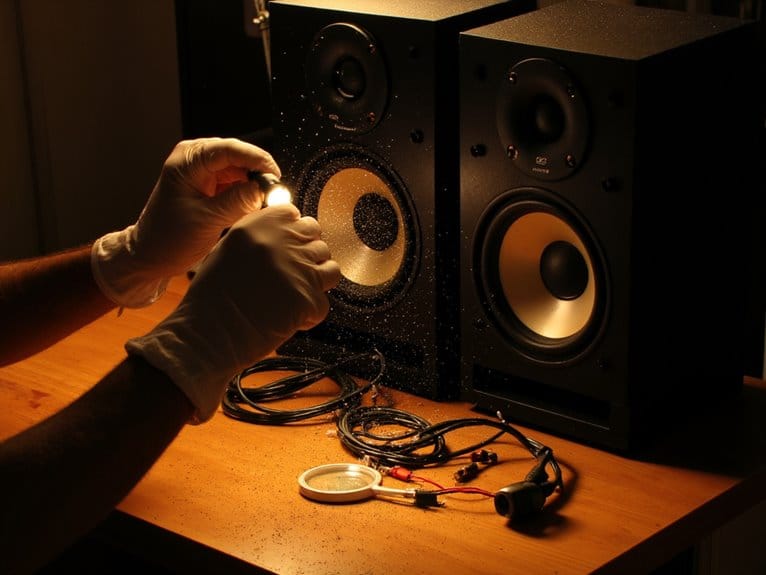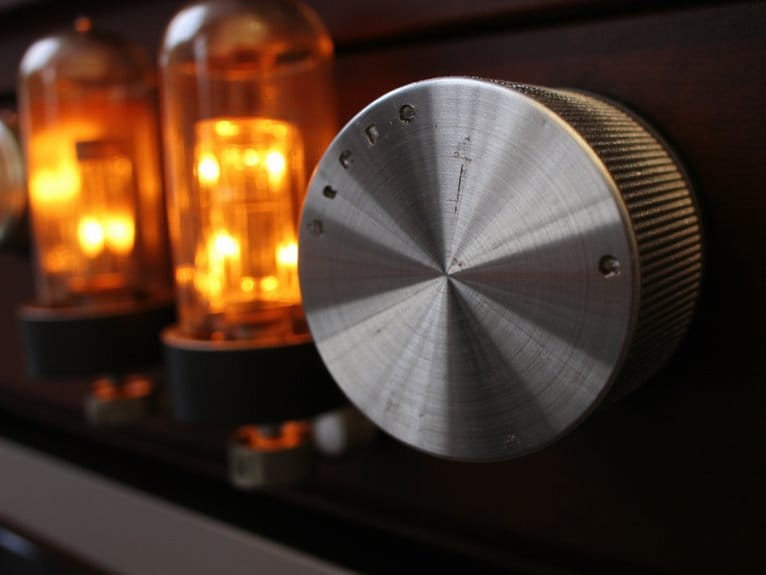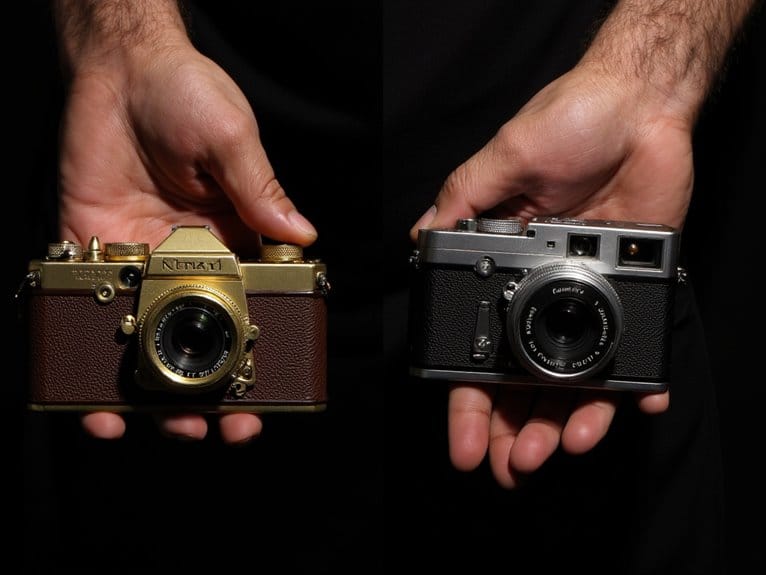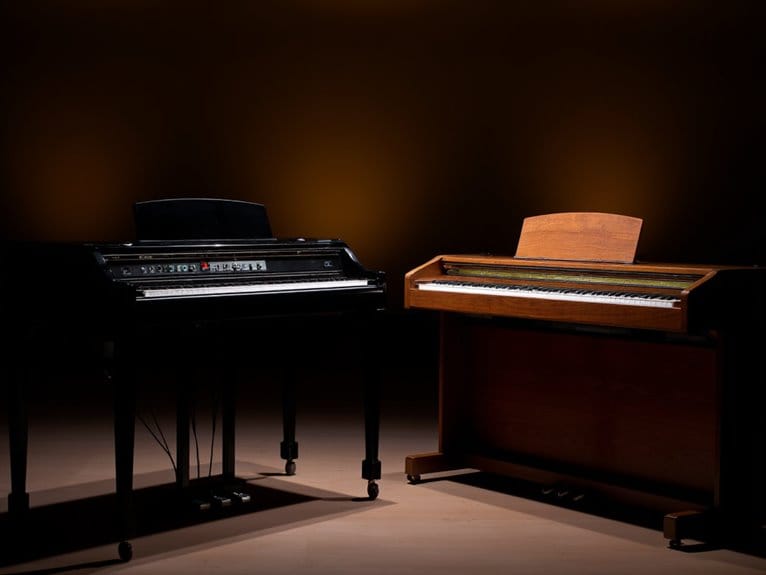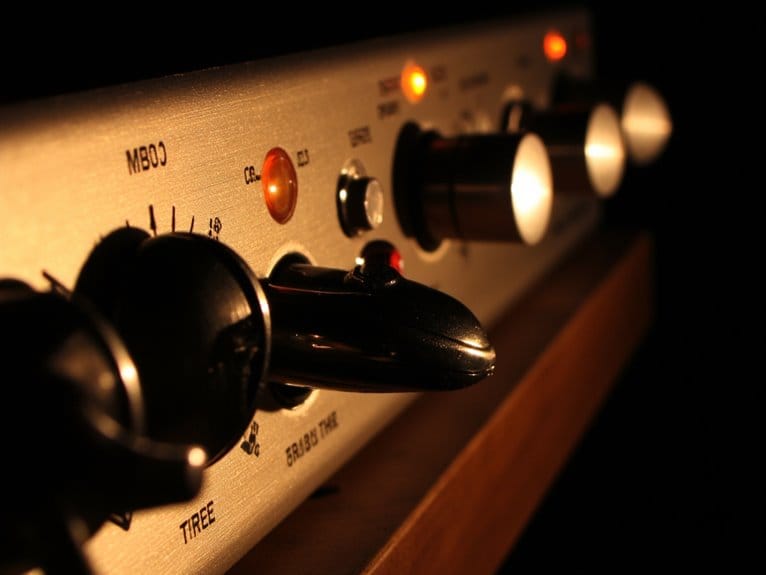Sidechain Processing: Creative Applications Beyond EDM
You’ll find sidechain compression‘s true power extends far beyond EDM’s signature pumping effects, serving as an essential tool for dialogue clarity in films, subtle rhythmic movement in jazz, and frequency management across all genres. It automatically ducks background elements when vocals appear, creates textural dynamics in sustained pads, and prevents frequency clashes through multiband processing. Advanced routing with pre-fader sends and EQ’d triggers opens creative possibilities that transform ordinary mixes into professionally polished productions with sophisticated spatial control.
We are supported by our audience. When you purchase through links on our site, we may earn an affiliate commission, at no extra cost for you. Learn more.
Notable Insights
- Sidechain compression enhances vocal clarity in dialogue by automatically ducking background music when speech is present.
- Jazz and indie genres use subtle sidechaining for sophisticated dynamic interactions without mechanical pumping effects.
- Multiband sidechain compression targets specific frequency ranges to prevent muddiness while preserving overall mix dynamics.
- Film and broadcasting rely on sidechaining to maintain dialogue intelligibility in complex soundscapes with competing elements.
- Advanced routing with pre-fader sends and EQ’d triggers creates frequency-targeted effects for creative sound design.
Vocal and Dialogue Enhancement Through Dynamic Ducking
When you’re mixing audio and struggling to make dialogue cut through a busy soundscape, dynamic ducking becomes your most reliable ally for achieving professional-level vocal clarity without sacrificing the richness of your background elements.
This sidechain compression technique automatically reduces background audio levels when vocal signals trigger the threshold, ensuring dialogue prominence while maintaining musical texture underneath.
You’ll set up a compressor on your background track, route your vocal signal to the sidechain input, then adjust threshold and sensitivity parameters until speech cuts through cleanly.
The attack and release times control how smoothly the background ducks and recovers, preventing that amateur pumping effect that screams “I learned this yesterday.”
It’s particularly effective for podcasts, film post-production, and broadcast scenarios. Testing across various playback systems ensures your ducking translates well from studio monitors to earbuds to car speakers.
Rhythmic Pumping and Textural Movement in Modern Production
While your grandmother might’ve called it “that annoying thumping,” rhythmic pumping through sidechain compression has become the secret weapon that transforms static synth pads and sustained elements into pulsating, breathing textures that make modern tracks feel alive.
You’re fundamentally using your kick drum as a conductor, triggering compression that creates those signature gaps and swells in sustained sounds, shifting the perceived rhythmic center through microtiming deviations that enhance groove perception.
Your kick becomes the metronome that sculpts space and time, carving rhythmic pockets that make listeners feel the groove rather than simply hear it.
The magic happens when you apply frequency-selective ducking to target specific bands, preventing muddiness while preserving harmonic detail.
This rhythmic dynamics approach works beyond basslines-try it on leads, pads, and keys for complex textural interplay.
Multiple concurrent sidechains create intricate movement patterns, while automation tailors these effects across different song sections, maintaining listener engagement through sophisticated envelope reshaping.
Frequency Management and Mixing Clarity Techniques
Beyond creating rhythmic movement, sidechain compression becomes your precision scalpel for carving out frequency space where competing elements clash, preventing the muddy mess that plagues untrained mixes.
Multiband sidechain compression lets you duck only specific frequency ranges, preserving the dynamic range of unaffected bands while maintaining each element’s frequency response. You’ll filter your sidechain input, focusing compression on problematic frequencies like that 150-300 Hz kick attack range, while leaving your bass’s sub-frequencies untouched.
I’ve found that automating threshold and release parameters between song sections creates breathing room where you need it most, enhancing mix clarity without sacrificing musical dynamics.
When setting up your signal chain, ensure your audio interface provides clean, low-noise preamps to maintain the integrity of your sidechain trigger signals throughout the compression process. Professional 16-channel mixers like the Yamaha MG16XU offer studio-quality D-PRE preamps that deliver the clean signal path essential for precise sidechain triggering without introducing unwanted artifacts.
- Apply high-pass filtering above 100 Hz on sidechain inputs for surgical precision
- Use multiband compression to duck competing low frequencies selectively
- Automate sidechain intensity between verses and choruses for dynamic contrast
- Target specific attack frequencies (150-300 Hz) for cleaner ducking effects
- Implement proper gain staging to prevent over-triggering and artifacts
Broadcasting, Film, and Cross-Genre Applications
Although electronic dance music dominates most sidechain discussions, professional broadcasting and film production rely heavily on this technique for maintaining dialogue clarity and creating seamless audio experiences that most listeners never consciously notice.
When you’re watching a movie or listening to a podcast, sidechain compression automatically ducks background music whenever someone speaks, ensuring you’ll never miss important dialogue buried under orchestral swells or ambient effects. This broadcast clarity becomes especially significant in complex soundscapes where multiple audio elements compete for attention.
Sound integration through sidechaining extends beyond traditional compression into jazz, indie, and cinematic music, where subtle dynamic interactions shape instruments around vocals without the mechanical pumping associated with dance music, creating sophisticated sound integration that enhances rather than dominates the listening experience.
Advanced Routing Strategies and Creative Sound Design
The real magic of sidechain processing unfolds when you master advanced routing techniques that transform this tool from a simple ducking effect into a sophisticated sound design weapon.
You’ll discover that pre-fader sends allow you to mute trigger tracks while maintaining sidechain control, and EQ’d signals can selectively trigger compression based on specific frequency content rather than raw audio.
Advanced modulation techniques enable dynamic signal shaping through multiband sidechaining, where compression affects only targeted frequency ranges.
You can rhythmically gate synth pads, modulate reverb sends to clear mix space, and automate threshold, ratio, and release parameters for evolving dynamics that adapt to different song sections.
- Route EQ’d trigger signals for frequency-selective compression control
- Use multiband compressors to sidechain specific frequency bands independently
- Automate sidechain parameters during shifts for musical adaptation
- Apply sidechaining to reverb sends for rhythmic space clearing
- Employ pre-fader sends for flexible trigger track management
On a final note
You’ve discovered that sidechain compression isn’t just an EDM trick-it’s a versatile tool that’ll transform your entire production approach. Whether you’re crafting cinematic dialogue, creating rhythmic movement in indie rock, or managing frequency conflicts in jazz arrangements, these techniques will elevate your mixes. I’ve found that understanding sidechain processing as a creative partner, rather than just a technical fix, opens doors you didn’t know existed in your studio workflow.


